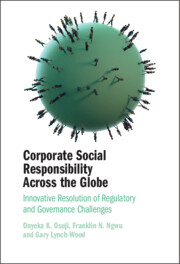 Corporate Social Responsibility Across the Globe
Corporate Social Responsibility Across the Globe from Part I - Regulation Concepts, Paradigms and Approaches for Corporate Social Responsibility
Published online by Cambridge University Press: 15 June 2023
The chapter uses global poverty as a case study subset of human rights to expand the smart-mix regulation discourse to the field of human rights where there is little legal affirmation of the methods for tackling challenges. It shows how the UN Guiding Principles on Business and Human Rights (UNGPs) exemplify governance reluctance and uncertainties in international human rights law. It argues that, if properly designed, corporate social responsibility (CSR) can potentially address governance gaps for human rights beyond the scope of the UNGPs. The chapter further shows that CSR can be utilised by willing actors for safeguarding rights and combating the unwillingness of powerful political and economic entities to accept the legalisation of business responsibility for human rights.
To save this book to your Kindle, first ensure no-reply@cambridge.org is added to your Approved Personal Document E-mail List under your Personal Document Settings on the Manage Your Content and Devices page of your Amazon account. Then enter the ‘name’ part of your Kindle email address below. Find out more about saving to your Kindle.
Note you can select to save to either the @free.kindle.com or @kindle.com variations. ‘@free.kindle.com’ emails are free but can only be saved to your device when it is connected to wi-fi. ‘@kindle.com’ emails can be delivered even when you are not connected to wi-fi, but note that service fees apply.
Find out more about the Kindle Personal Document Service.
To save content items to your account, please confirm that you agree to abide by our usage policies. If this is the first time you use this feature, you will be asked to authorise Cambridge Core to connect with your account. Find out more about saving content to Dropbox.
To save content items to your account, please confirm that you agree to abide by our usage policies. If this is the first time you use this feature, you will be asked to authorise Cambridge Core to connect with your account. Find out more about saving content to Google Drive.